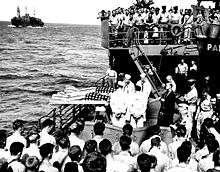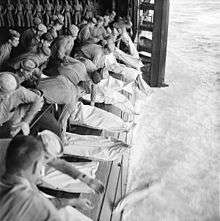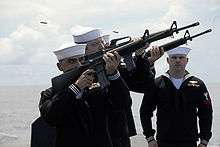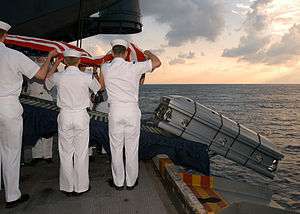Burial at sea
Burial at sea is the disposal of human remains in the ocean, normally from a ship or boat. It is regularly performed by navies, and is done by private citizens in many countries.
_prepare_to_cast_ashes_overboard_during_a_burial_at_sea.jpg)

Burial-at-sea services are conducted at many different locations and with many different customs, either by ship or by aircraft. Usually, either the captain of the ship or aircraft or a religious representative (of the deceased's religion or the state religion) performs the ceremony.
The ceremony may include burial in a casket, burial sewn in sailcloth, burial in an urn, or scattering of the cremated remains from a ship. Burial at sea by aircraft is usually done only with cremated remains. Other types of burial at sea include the mixing of the ashes with concrete and dropping the concrete block to form an artificial reef such as the Atlantis Reef.
Below is a list of religions that allow burial at sea, with some details of the burial.
By religion
Christianity
Catholicism
Officially, the Roman Catholic Church prefers normal casket burials over cremations, but does allow for cremation subject to the condition that the ashes are entombed or buried. Catholics believe it is not proper to scatter or pour the cremated remains over the sea, water, or on the land. According to the Roman Catholic Church this action does not give due respect to the remains of the deceased, nor does it allow for the closure and healing of family and friends. Likewise they see that the custom of housing the remains with family or friends and not placing the deceased in the ground does not offer loved ones a specific and sacred place to visit the individual. Visiting the deceased in a holy place provides believers with a space to offer prayers, commune with those who have gone before them in faith, and reminds them to await the resurrection of their own bodies. Burial at sea in a casket or in an urn is approved for cases where the deceased expired in the sea. The committal prayer number 406§4 is used in this case.[1]
Protestantism
The Anglican Communion has detailed procedures for burial at sea. The ship has to be stopped, and the body has to be sewn in canvas, suitably weighted. Anglican (and other) chaplains of the Royal Navy bury cremated remains of ex-Naval personnel at sea. Scattering of cremated remains is discouraged, not least for practical reasons
The Book of Common Prayer (1928) of the Protestant Episcopal Church in the United States (ECUSA), a member of the Anglican Communion provides a specific prayer of committal for burials at sea:
At the Burial of the Dead at Sea. The same Office may be used; but instead of the Sentence of Committal, the Minister shall say:
Unto Almighty God we commend the soul of our brother departed, and we commit his body to the deep; in sure and certain hope of the Resurrection unto eternal life, through our Lord Jesus Christ; at whose coming in glorious majesty to judge the world, the sea shall give up her dead; and the corruptible bodies of those who sleep in him shall be changed, and made like unto his glorious body; according to the mighty working whereby he is able to subdue all things unto himself.[2]
Many Lutheran naval veterans and seamen prefer to be buried at sea. In those cases either the casket or urn is set to sea, or ashes scattered. The procedure is similar as that with the Anglican church. Some parishes have specific consecrated sea areas where ashes can be sprinkled.
Hinduism
Traditionally, the deceased are cremated, the bones and ashes are collected, and the ashes/remains are immersed in the Ganges River if possible or in any other river if not.
Islam
The sacred texts of Islam prefer burial on land, "so deep that its smell does not come out and the beasts of prey do not dig it out". However, if a person dies at sea and it is not possible to bring the body back to land before decay, or if burial at land becomes impossible, burial at sea is allowed. A weight is tied to the feet of the body, and the body is lowered into the water. This would preferably occur in an area where the remains are not immediately eaten by scavengers.
In the Sunni Fiqh book Umdat al-Salik wa Uddat al-Nasik, the condition for sea burial is:
It is best to bury him (the deceased) in the cemetery ... If someone dies on a ship and it is impossible to bury him on land, the body is placed (O: tightly lashed) between two planks (O: to obviate bloating) and thrown into the sea (O: so that it reaches shore, even if the inhabitants are non-Muslims, since a Muslim might find the body and bury it facing the direction of prayer (qibla)).[3]
Judaism
According to Jewish law, dead people must be quickly buried and burial requires covering in earth.[4] This law is derived from Devarim (Deuteronomy) 21:23 "Bury, you will bury him the same day; for the (unburied body) is a curse to God" the double command to bury causing a positive commandment to entomb in the earth and a negative commandment forbidding leaving an unburied body. The legal text Shulchan Aruch brings a case example explaining that even if a person is known to have drowned in a closed body of water such as a small pond where there can be certainty that the victim had not somehow survived, the family does not begin ritual mourning and remains in extended state of most intense mourning aninut until either the body is found or after an exhaustive search despairs of recovering and burying the body.[5] This shows that the body is considered unburied when underwater; as shiva mourning normally only begins after burial. B'resheit (Genesis) 3:19 states "With the sweat of your face you shall eat bread, until you return to the ground, from (dust) you were taken and you are dust, and to dust you will return." From this it has been deduced by rabbis that the only proper treatment of a dead body is physically to cover it with earth once land is available for the crew to bury the body, rather than to leave the body at sea or some other fate such as cremation.
If for some reason the body of someone deceased aboard a ship causes an immediate life threat to those aboard the vessel the commandment to protect innocent life or pikuach nefesh overrides nearly all commandments including the command to bury the dead, as any appropriate actions to ensure safety of surviving crew are required to be taken which may include jettisoning a body at sea without burial. However, attempts would later be made to recover and bury when possible without life hazard.[6]
An example of the desire to bury a body in the ground even after it has been long dead at sea, is that of the Israeli submarine Dakar which was lost with no survivors in 1968 but whose location was not discovered until 1999 lying broken at a depth of 3,000 meters. Search and recovery of any potentially existing remains at this very difficult to access depth has not shown results despite requests from family and the Chief Rabbi of the Israel Defense Forces.[7][8][9] In another case Jewish rabbis, after finding of the remains of Holocaust victims using a new penetrating sonar technology, called for a proper Jewish burial claiming that many of these martyrs were adherent to traditional Jewish law themselves and would insist on being removed from a river, where Nazis had dumped them en masse, to rest in a proper in-earth Jewish burial.[10]
By country
Australia
Burial at sea within Australian territorial waters, exclusive economic zone and continental shelf is covered by the Environmental Protection (Sea Dumping Act) 1981 administered by the federal Department of the Environment. A permit is required for burial of bodies at sea. Permits are usually only granted in cases of a strong connection to the sea, such as long-serving navy personnel. The body must not be embalmed or placed in a casket, it may only be sewn into a weighted shroud. The burial must be in water deeper than 2,000 metres (6,600 ft) and not interfere with shipping, fishing or undersea communications. Australian Defence Force vessels engaged in armed conflicts or emergency situations are exempt from these requirements.[11]
No permit is required to scatter ashes at sea.
United Kingdom
British burials at sea of the 18th and 19th century involved wrapping the deceased in sailcloth weighted with cannonballs.
In England, cremated remains may be scattered freely at sea but a burial must be made in a coffin meeting regulatory requirements and in one of three locations: off The Needles, Isle of Wight; between Hastings and Newhaven; and off Tynemouth, North Tyneside. Permission may be sought for another burial site.[12] Some funeral directors will arrange the event. Charity organisation the Maritime Volunteer Service also helps carry out burials at sea.[13]
In Scotland, there are two designated sites for burial at sea. These are 210 miles (340 km) due west of Oban and 15 miles (24 km) west of John O'Groats.[14]
United States
A funeral director is not required for the burial of cremated remains at sea. However, full body burials require specific preparation to ensure the body or coffin sinks quickly, and in many states a licensed funeral director is required.[15] The Environmental Protection Agency regulations for full body burials at sea in the United States require that the site of interment be 3 nautical miles (5.6 km; 3.5 mi) from land and at a depth of at least 600 feet (180 m). In California, a whole body must be buried at least three miles off the coast. Off the eastern coast of the United States, the closest sufficient depths are off Long Island (75 miles/121 km), Ocraacoke (20 miles/32 km), and Miami (5 miles/8.0 km). This may require travel in excess of 30 miles (48 km) for a suitable site.[16]
Departing from the New England area requires a voyage of about 45 miles (72 km) to reach the required 600 ft ocean depth.[15] Sufficient depth is within 10 miles (16 km) or less at many harbors along the U.S. west coast, including San Diego, Santa Barbara, Monterey, Fort Bragg, Eureka, and Crescent City, all in California.[17] The United States Navy inters intact remains from Norfolk and San Diego only.[18] The United States Navy requires a metal casket for intact remains, but full body burial in a suitably weighted shroud is also legal.[15]
The United States is similar to many countries which permit the spreading of cremation ashes within their Exclusive Economic zone. When spreading ashes from a ship which is registered in a different country, the regulations and reporting procedures for the ship's flag state need to be complied with once the vessel is in international waters, that is, outside 12 nautical miles (22 km). Ships follow the London Convention principles, as opposed to MARPOL regulations, as the ash is intentionally taken on board for discharge at sea, as opposed to ash generated on passage from the ship's incinerators. It should be further considered that on 1 January 2013, MARPOL Annex V came into force, which prevents discharge of a ship's incinerator ash.
United States Navy
.jpg)
The United States Navy has performed many burials at sea in its history, with wartime burials as recently as World War II, and peacetime burials still common. Enemy deaths received the same ceremony as Americans or allies. Most other armed forces also perform burials at sea, such as the British Royal Navy and the Royal Canadian Navy.
If the deceased died on land or has been returned to shore after death, the remains may be brought aboard either in a coffin or in an urn after cremation. The ceremony is performed while the ship is deployed, and consequently civilians are not allowed to be present. In the US, people eligible for a free Navy burial at sea are:
- Active-duty members of the uniformed services
- Retirees and honorably discharged veterans
- Military Sealift Command U.S. civilian marine personnel
- Family members of the above
In preparation, the officer of the deck calls All hands bury the dead, and the ship is stopped (if possible). The ship's flags are lowered to half mast. The ship's crew, including a firing party, casket bearers and a bugler, are assembled on the deck. The crew stands at parade rest at the beginning of the ceremony. The coffin is covered with a flag, and is carried feet first on deck by the casket bearers. The casket is placed on a stand, with the feet overboard. In case of cremated remains, the urn is brought on deck and placed on a stand.
The ceremony is divided into a military portion and a religious portion. The religious part is specific to the religion of the deceased, and may be performed by a Navy chaplain, or by the commanding officer if no chaplain of the appropriate faith is available. A scripture is read and prayers are said.
After the religious ceremony, the firing party is ordered "Firing party, present arms". The casket bearers tilt the platform with the casket, so that the casket slides off the platform into the ocean. The flag which was draped over the casket is retained on board. For cremated remains, there is the option to bury the remains using the urn in a similar fashion to the procedure used for caskets. Alternatively, the urn can be opened, and the remains scattered in the wind. In this case, the wind direction has to be taken under consideration before burial to ensure a smooth procedure.
The firing party fires a three volley salute, the bugler plays Taps, and flowers may also be dropped into the ocean. After the flag is folded, the ceremony ends. The relatives are informed of the time and location of the burial, and given photos and video recordings if available.
Wartime burial at sea



.jpg)
In wartime, attempts are made for burial at sea to follow the same procedure as for peacetime burial at sea, although a ship on a combat mission may not have all the necessary resources available. Nowadays, it is usually possible to airlift the remains back to shore, and prepare a burial ceremony on land. However, as recently as the Falklands War, deceased were buried at sea without returning to land. Due to the limited facilities of military ships, this procedure usually does not include a casket, but the body is sewn into a sailcloth with weights, usually rocks or cannonballs. Cremation is usually not possible on a ship. During the Pacific campaign there was at least one instance where a member of an aircrew was buried at sea in his damaged aircraft, which was ceremonially pushed overboard from an aircraft carrier.[19][20]
Memorial services at sea
If no remains of the deceased are available a memorial service may be held, and flowers may be dropped in the water, often over or near the location of the death.
People buried at sea
A few notable burials at sea:
- Sir Francis Drake (1540–1596), body in lead coffin off the coast of Portobelo, Panama
- Andrew Cunningham, 1st Viscount Cunningham of Hyndhope (1883–1963), prominent admiral of the Royal Navy during World War II. Buried at sea near Portsmouth.
- Christopher Newport (1561–1617), body buried in the Indian Ocean
- Edward Winslow (1595–1655) buried at sea near Jamaica on 8 May 1655
- Numerous RMS Titanic victims (1912), picked up by rescue ships, whose remains were too damaged to preserve or for whom the rescuers lacked sufficient embalming materials, were buried at sea. The ashes of Titanic's fourth officer, Joseph Boxhall, were scattered at sea following his death, aged 83, in 1967, at 41°46N 50°14W, the position he had calculated for the ship on the night of the sinking.
- Dame Edwina Mountbatten, Countess Mountbatten of Burma (1901–1960), was buried at sea off the coast of Portsmouth, as it was her wish to be buried at sea.
- Mariano Moreno (1778–1811), one of the leaders of the Argentine May Revolution; died on voyage to the United Kingdom, possibly poisoned; his coffin was wrapped in a British flag.
- Surya Sen (1894–1934), was given a burial at sea in the Bay of Bengal
- Dudley Pound (1877–1943), cremated ashes scattered
- H. G. Wells (1866–1946), cremated and ashes scattered in the sea off England
- Adolf Eichmann (1906–1962), following his execution in Israel, his body was cremated and his ashes scattered at sea over the Mediterranean, in international waters. This was done because Israel did not want such a person buried in its soil, and also did not want a grave elsewhere that might have become a place of pilgrimage for other Nazis.
- Janis Joplin (1943–1970), cremated at Westwood Village Memorial Park Cemetery, and ashes scattered into the Pacific Ocean
- Richard Rodgers (1902–1979), cremated ashes scattered
- Sir Alfred Hitchcock (1899–1980), ashes were scattered into the Pacific Ocean
- Steve McQueen (1930–1980), cremated and ashes scattered in the Pacific Ocean
- Dennis Wilson (1944–1983), body buried in the Pacific Ocean off California with special intervention by President Reagan
- Peter Lawford (1923–1984), actor, cremated and ashes originally buried at Westwood Village Memorial Park Cemetery; they were later removed and scattered in the Pacific Ocean
- Rock Hudson (1925–1985), cremated ashes scattered
- Robert A. Heinlein (1907–1988), cremated, and ashes scattered in the Pacific Ocean[21]
- Stan Getz (1927–1991), cremated, and ashes scattered in the Pacific Ocean off Malibu, California
- Vincent Price (1911–1993), ashes scattered off Point Dume in Malibu, California
- Gene Kelly (1912–1996), cremated ashes scattered
- Robert Mitchum (1917–1997), cremated ashes scattered
- John F. Kennedy, Jr (1960–1999), scattered into the Atlantic Ocean by the U.S. Navy off Martha's Vineyard
- DeForest Kelley (1920–1999), ashes scattered into the Pacific Ocean
- Doug Henning (1947–2000), cremated, and ashes scattered into the Pacific Ocean of Redondo Beach, California
- Werner Klemperer (1920–2000), cremated ashes scattered
- Sir Edmund Hillary (1919–2008), cremated, and ashes scattered in New Zealand's Hauraki Gulf[22]
- Leyla Gencer (1928–2008), ashes scattered into the Bosphorus
- Osama bin Laden (1957–2011);[23] one U.S. official stated that "finding a country willing to accept the remains of the world's most wanted terrorist would have been difficult".[24] It was also done to prevent his burial place from becoming a "terrorist shrine".[25]
- Dick Clark (1929–2012), cremated and ashes were scattered into the Pacific Ocean
- John Carradine (1906–1988), full body burial into the Pacific Ocean near Santa Catalina Island (California) by his family
- Neil Armstrong (1930–2012), cremated, ashes scattered into the Atlantic Ocean from the U.S. Navy cruiser Philippine Sea[26]
- Atholl MacGregor, Hong Kong's chief justice, died on hospital ship from Hong Kong for England
- Robin Williams (1951–2014), cremated the day after his death, ashes scattered in San Francisco Bay
- Liu Xiaobo (1955–2017), 2010 Nobel Peace Prize laureate, ashes scattered into the ocean off north-eastern China.[27]
- Abu Bakr al-Baghdadi (1971–2019), Caliph of the Islamic State of Iraq and the Levant. Remains were buried at sea after Abu Bakr detonated a suicide vest during a raid by US forces; as with bin Laden, the sea burial was carried out according to Islamic rites.[28][29][30][31]
See also
| Wikimedia Commons has media related to Sea burials. |
- Illegal disposal of bodies in the water
- Military funeral
- Natural burial
- Viking funeral
References
- Accessed December 11, 2017
- Book of Common Prayer (1928), p. 337 [The Church Pension Fund]
- Reliance of the Traveller, Ahmad ibn Naqib al-Misri, p 237, Translated by Nuh Ha Mim Keller, Amanah publications, ISBN 0-915957-72-8
- Shulchan Aruch, Yoreh Deah 362:1.
- Shulchan Aruch, Yoreh Deah 375:7
- Leviticus 18:5 "אֲשֶׁר יַעֲשֶׂה אֹתָם הָאָדָם וָחַי בָּהֶם"
- "Israel tries again to solve mystery of sub lost in '68". baltimoresun.com. Retrieved 5 April 2018.
- Guttman, Nathan (2 February 2003). "NASA Says Remains of All 7 Astronauts Recovered, Then Retracts". Retrieved 5 April 2018 – via Haaretz.
- Bochner, Uri Dotan. "Search and Discovery of the Israeli Submarine Dakar". submarines.dotan.net. Retrieved 5 April 2018.
- https://jewishstandard.timesofisrael.com/in-hungary-a-jewish-community-fight-taints-effort-to-bury-holocaust-victims/
- "Environmental Protection (Sea Dumping Act) 1981". Australian Government.
- "Burial at sea". Retrieved 30 August 2015.
- "Burial at sea: Seven things you might not know". Retrieved 25 September 2018.
- "Burials at Sea". Scottish Government. Retrieved 23 July 2018.
- "New England Burials at Sea - Ash Scatterings at sea - Full Body Sea Burials - Eco Friendly Sea Burials- Burial Shrouds - USCG Licensed Captain - Burials at sea - Sea Burials". www.newenglandburialsatsea.com. Retrieved 5 April 2018.
- "Federal Register, Volume 40, Section 229.1".
- Google Earth bathymetry
- staff, US Navy web. "The U.S. Navy". www.navy.mil. Retrieved 5 April 2018.
- "In memory of Loyce Edward Deen USNR WW II, (1921 - 1944) and all who served aboard the USS Essex".
- "U.S. Navy TBF Avenger gunner from USS Essex is buried at sea with his aircraft during World War II". Criticalpast. 5 November 1944.
- "Heinlein Society". www.heinleinsociety.org. Retrieved 5 April 2018.
- "Sir Edmund Hillary takes final voyage, ashes scattered at sea". The New Zealand Herald. 29 February 2008. Retrieved 22 September 2011.
- "Osama bin Laden's body buried at sea". 2 May 2011.
- "Yahoo report". yahoo.com. Retrieved 5 April 2018.
- Osama Bin Laden Body Headed for Burial at Sea, Officials Say - The Note Archived 2011-05-02 at the Wayback Machine
- "Neil Armstrong's remains committed to the sea". CNN. 14 September 2012. Retrieved 15 September 2012.
- Phillips, Tom (15 July 2017). "Liu Xiaobo: dissident's friends angry after hastily arranged sea burial". the Guardian. Retrieved 5 April 2018.
- "Baghdadi's body disposed of at sea by US military: Pentagon source". Gulf News.
- "Baghdadi given burial at sea, afforded religious rites: U.S. officials". Reuters. 28 October 2019.
- "Al-Baghdadi given burial at sea, afforded religious rites". The Jerusalem Post.
- "US says it took two prisoners during al-Baghdadi raid". Al Jazeera.